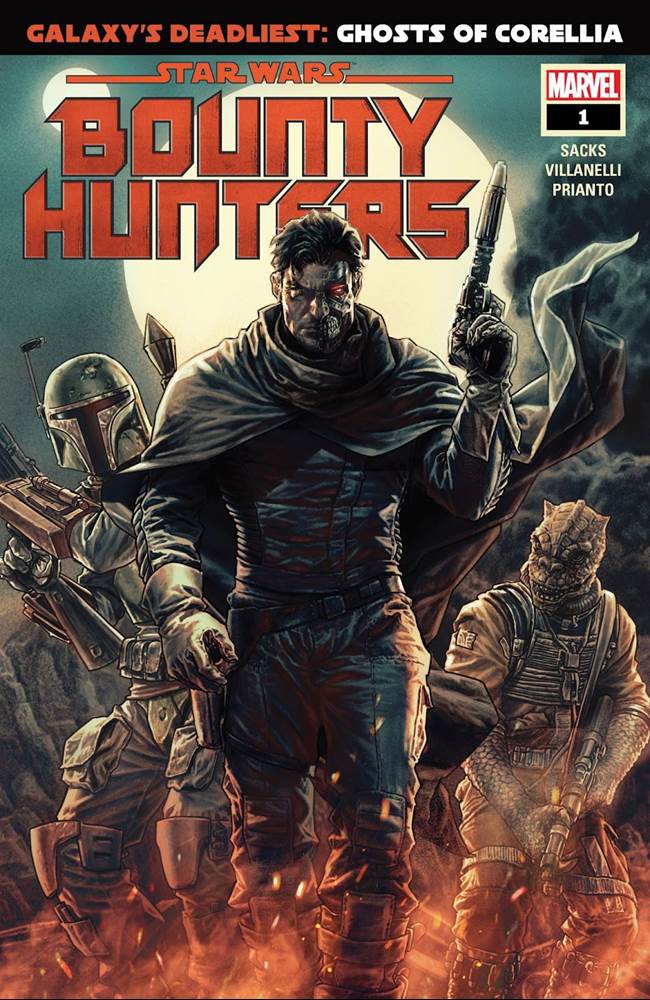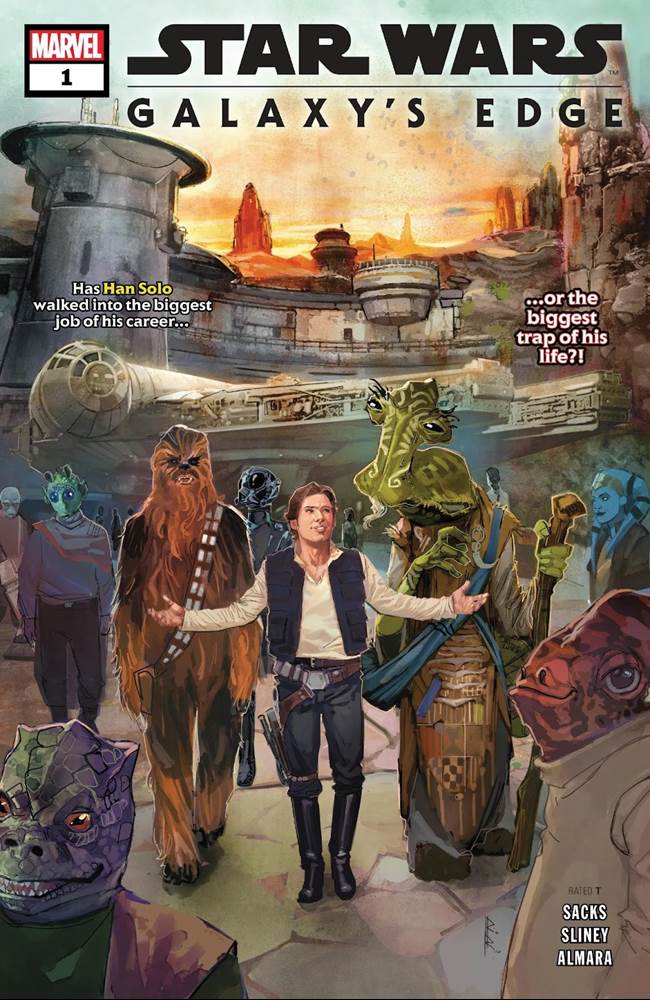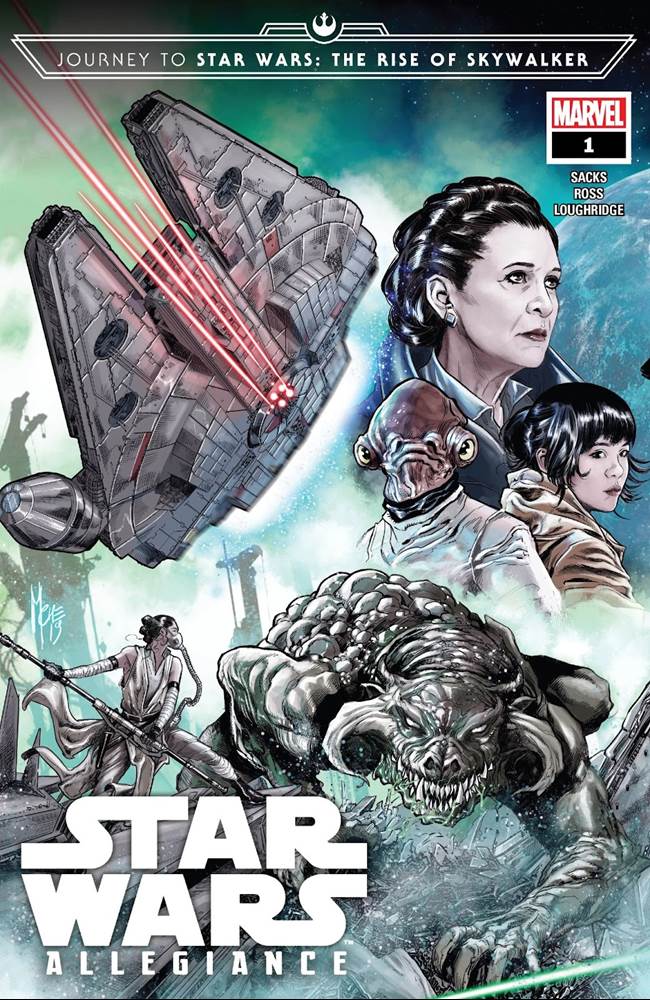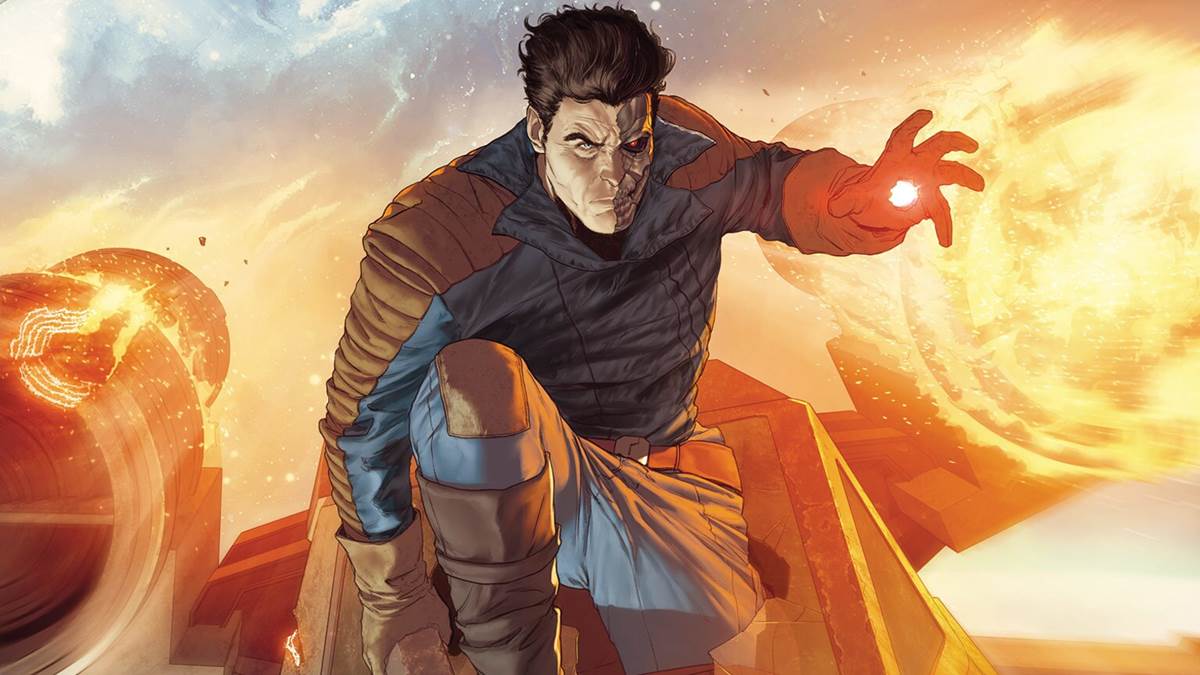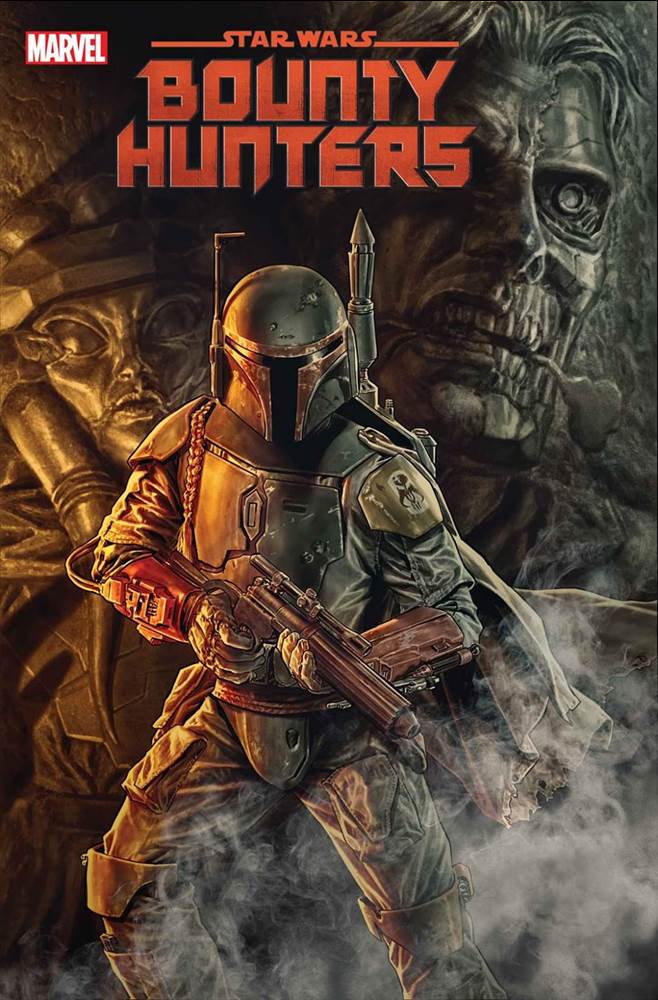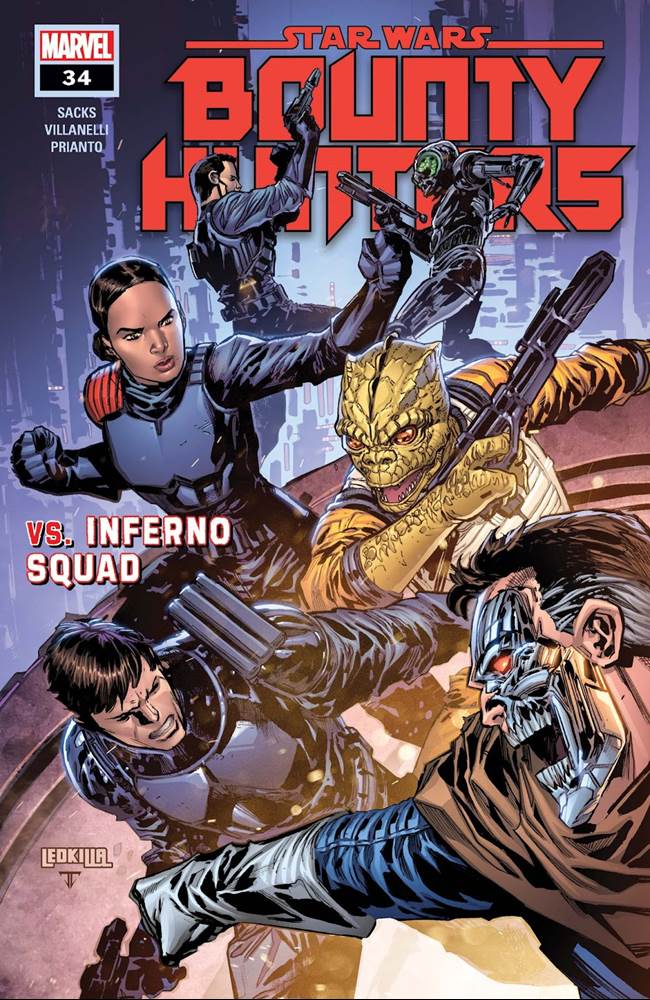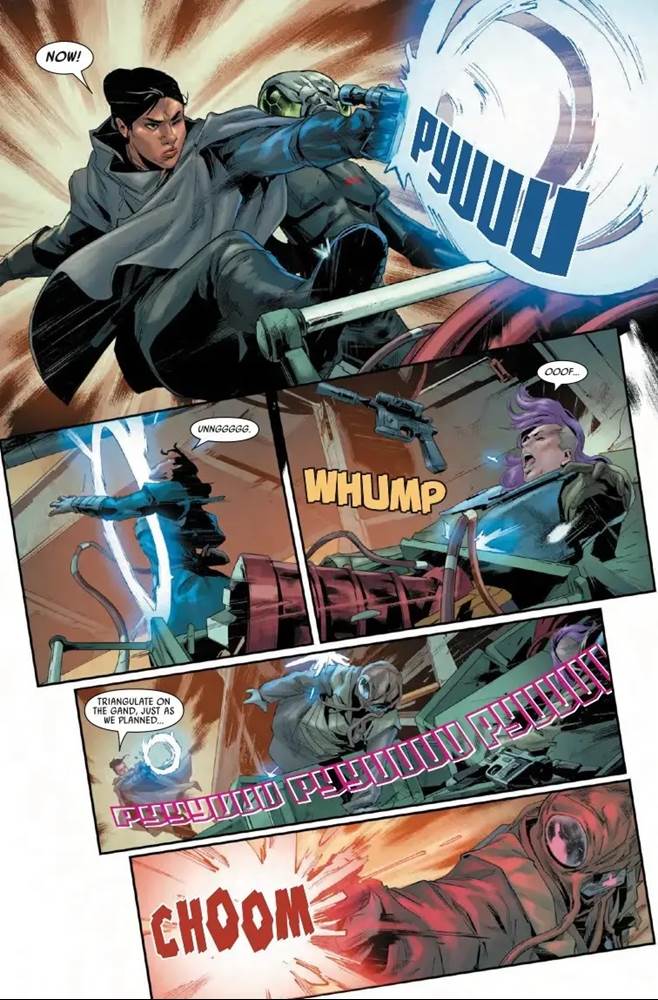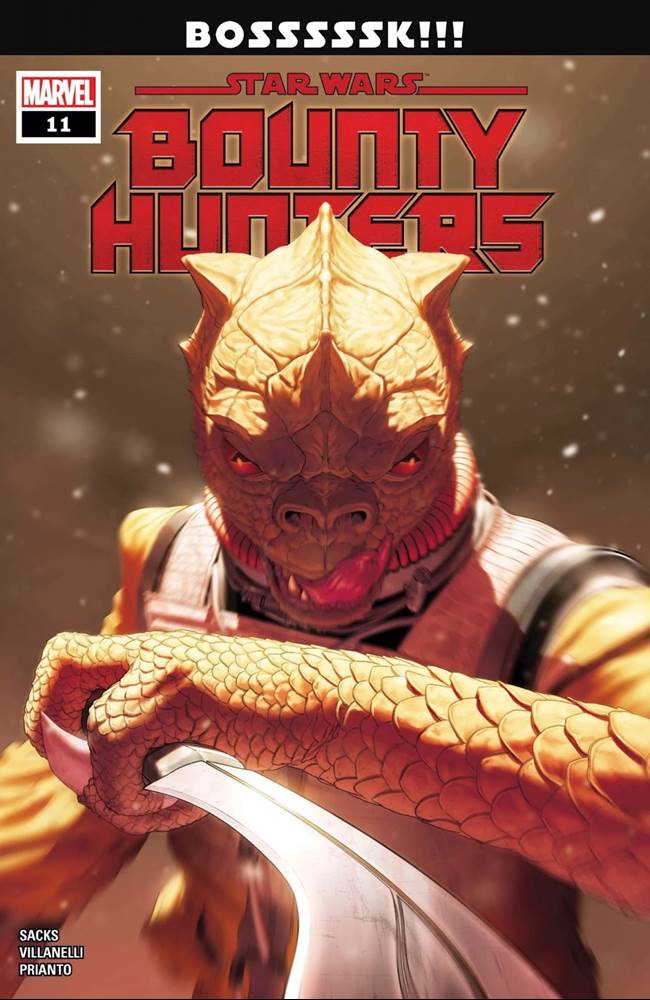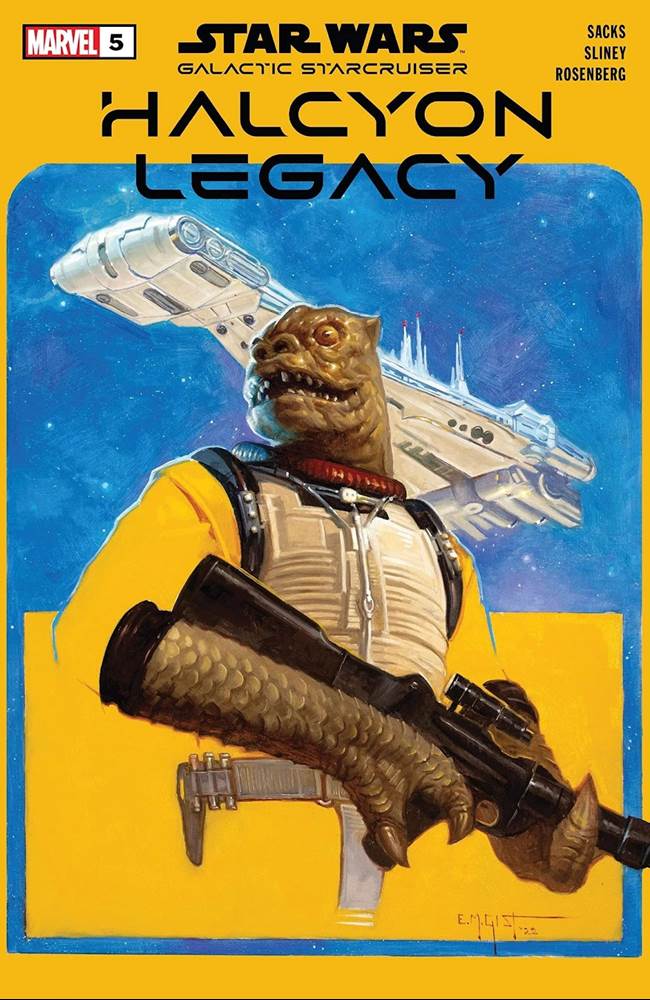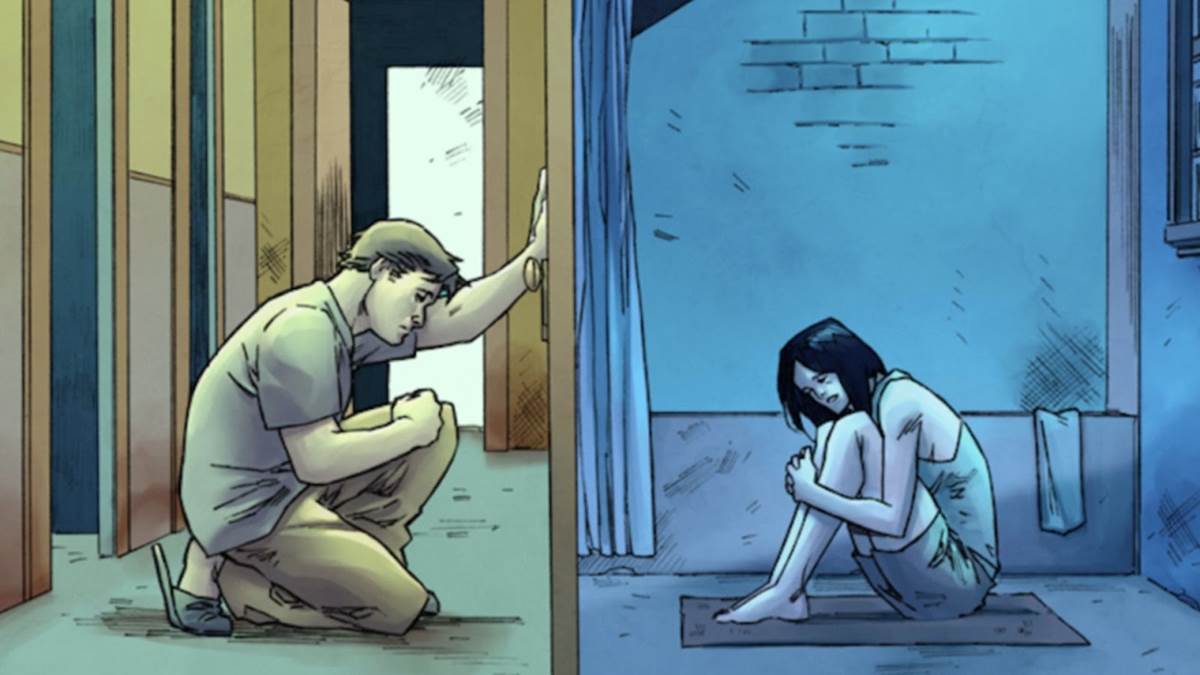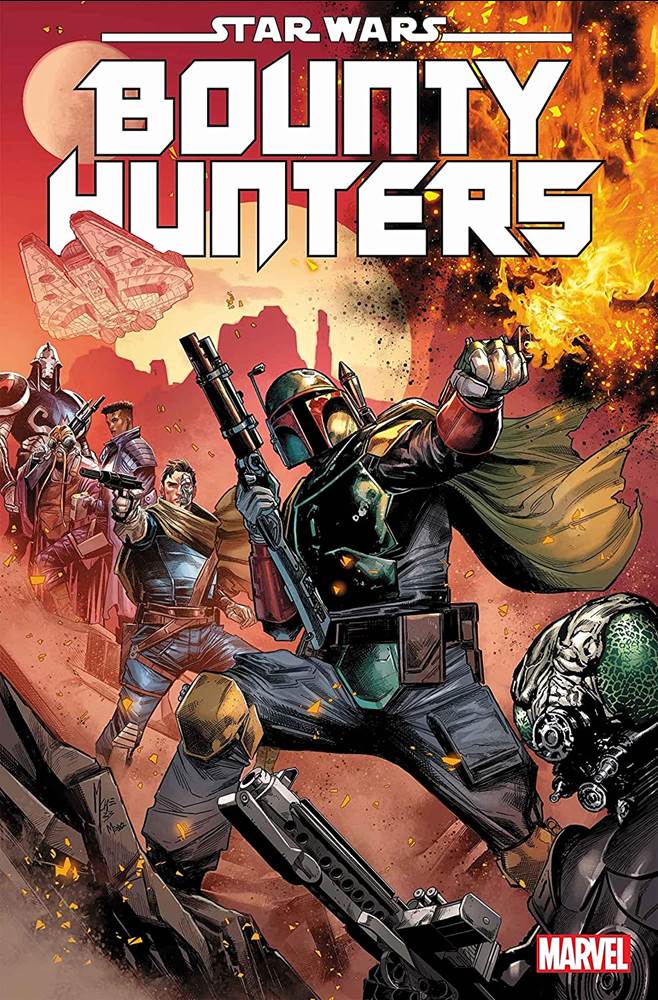Marvel Comics writer Ethan Sacks has been contributing to the Star Wars storytelling universe for just a few years, but he’s already made an impressive stamp with his ongoing Star Wars: Bounty Hunters title, in addition to acclaimed miniseries tied into the Disney Parks experiences Star Wars: Galaxy’s Edge and Star Wars: Galactic Starcruiser, and helping to set the stage for the release of the movie Star Wars: The Rise of Skywalker.
With Bounty Hunters approaching its 35th issue later this month, I was thrilled to be given the opportunity to sit down with Ethan Sacks to discuss his comic writing career, his history as a Star Wars fan, and his thoughts on what we now know to be the final days of the Halcyon.
Mike Celestino, Laughing Place: What was your relationship with Star Wars growing up? Were you a fan?
Ethan Sacks: Yes. Actually, one of my very first memories… this is gonna date me as old… I was four years old when A New Hope– then Star Wars– came out, and it’s one of my first vivid memories in my life. It’s so vivid: my father took me in the summer of 1977 to a Loews theater in Times Square, New York. I can still remember what it was like to be in that seat, see the Star Destroyer come overhead, hear the John Williams score. It was like nothing else I had ever seen, and that memory is so vivid that it’s like my father is still alive next to me, and my father died in 1995. It’s like I can hear his voice– it’s just really a very vivid memory. And I was hooked from there. As an aside, I got to tell that story– that same first encounter with Star Wars– to Carrie Fisher, Mark Hamill, Anthony Daniels, and George Lucas, and they each had very different reactions. George Lucas looked a little horrified. [laughs] Like, ‘Oh, it’s gonna be one of these people.’
LP: How did you get started as a writer? Tell me about the beginning of your career and how you came to work for Marvel Comics.
Sacks: I took a very roundabout path, because I was a newspaper journalist for 20 years. And one of the best things I got to do at the New York Daily News where I worked was the so-called ‘Geek Beat,’ and that was everything from comic books to Star Wars… eventually Game of Thrones and Walking Dead and all sorts of things like that. I fell into it because at the time I started I was fairly young, and nobody else that was a reporter there was that into this stuff. So I just kinda lucked into it. It was part of my job, not my entire job. I got to know, over the years, a number of people in comics, including [becoming] good friends with Joe Quesada, former Editor-In-Chief of Marvel, and then later the Chief Creative Officer. That’s where he was when this story begins, and in 2016 for May the 4th– the all-important national holiday– for the Daily News I pitched a story where I interviewed the actor who played Greedo, Paul Blake, who died not that long after that. Just a hilarious guy, and the subject came up over who shot first– whether it was Han or Greedo. And he was almost like a stand-up comic; he just had this routine nailed down pat. It was hilarious, because he would be like, ‘I know Greedo’s eyes. He’s got those myopic eyes. Maybe he should have been in flower arranging instead of bounty hunting.’ He just kept going, but then he said in the script it said, ‘Han shoots the alien.’ So I left this interview, and it got stuck in my mind, and I thought, ‘It’d be kind of funny to tell the Greedo murder like Akira Kurosawa’s Rashomon,’ like a murder investigation from different accounts.
It just stuck in my head, and so I was at a New York Mets game with Joe Quesada, and I was like, ‘Hey, I have this idea. I can’t let go of it. I think it’s funny. Would you mind if I did a spec script for a Star Wars comic? [If] you guys don’t like it, [it’s] totally fine. If you print it, because I’m working at the newspaper, I’ll just donate the proceeds to charity or whatever. It’s just something I have in my head. I’d like to get it out.’ And he was like, ‘Sure, whatever.’ He’s not excited. [laughs] So I took it very seriously, because I had never written a comic script before. I’d read a lot of them during the course of my reporting, and I reverse-engineered the ones I liked– the pacing, the format, all that kind of stuff. I contacted Lucasfilm– I had some contacts in the publicity department from my reporting– and they put me in touch with Pablo Hidalgo, who is on the [Story Group]. He told me what I could and couldn’t do, and I settled on this character Kitster, who is a friend of young Anakin’s in The Phantom Menace. But the important thing is there’s only two things relative [to Kitster] in canon. He has a whole other story in Legends, but as far as canon goes, up until Greg [Pak]’s Darth Vader run recently, he didn’t really have a role. And in a deleted scene, which is canon, in Phantom Menace, he’s watching as Anakin is pummeling baby Greedo. So it was like, ‘Hey, he was a childhood friend of both Anakin and Greedo. There’s my homicide detective.’
Who in Mos Eisley would investigate this? Because they literally turn around [and ignore it] when someone is killed. I figured the homicide cops there would be by-the-numbers and not really care, but there’s a reason for him to go into this. Anyway, long story short, I sent it in to Joe. I didn’t hear anything for months. I went to Japan to visit my in-laws with my family, and then on my way back I get an email from Joe, and the subject line is ‘F Greedo.’ So I was like, ‘Okay, this really went bad.’ But the gist of [the email] was, ‘F Greedo– you can actually write comic books. This is a fantastic first attempt.’ He said, ‘I think you should be doing this for a living.’ And then it became going from this weird idea I just wanted to get out to [being] like, ‘Is this possible?’ Serendipity, the newspaper was announcing that buyouts were available. And I had been there 20 years, so it was seven months' pay. If you’re gonna try a career change, that was my chance. Long story short, he put me in touch with Axel Alonso, who was then Editor-In-Chief. They never published that [Greedo] comic; Lucasfilm turned it down, but they did like it. And a few months later I got Old Man Hawkeye, which was my first major comic-book hit. The universe works in strange ways.
LP: Your first Star Wars story that got published was for an issue of the Age of Republic anthology series, but I want to ask about the Star Wars: Galaxy’s Edge miniseries. How did that come about for you, and how did you cook up the idea for that miniseries? How did you write about something that wasn’t accessible to you, since Galaxy’s Edge hadn’t opened yet at the time?
Sacks: After that ten-page Mace Windu story that was my entry point, the way I had gotten into the Star Wars office was Tom Groneman, who was the Assistant Editor for the Star Wars line at the time. He contacted me because he had the chance to edit a Silver Surfer Annual. So we worked together, and we just had this really great working relationship. He brought me into Star Wars, and they were looking for something for me to do. This miniseries was coming up, and of course I said ‘Yes.’ I would do anything in Star Wars, but this… I am a parks fan, and not only that– the idea of having a physical space where you can live Star Wars blew my mind. So I was all in. The little asterisk on this all was, because there were different publishing projects going on with Galaxy’s Edge, what I was given was Dok-Ondar’s story. It was going to be an anthology series– five completely separate stories, and I didn’t love that. My take, as a comic-book fan, is if you do an anthology series, it’s not really a series. It’s a collection of issues, and you can take or leave whichever ones you’re not interested in. And I wanted to give a cohesive story that made you want to read the whole thing, and maybe learn bits and pieces from all five issues. So I came up with a framing story. I knew I wanted to do a heist-type story, because there are all these cool artifacts [in Dok-Ondar’s shop], so we could have some of these artifacts play into the heist. That was my idea, without having known anything else about Galaxy’s Edge.
Now, as you mention, it was not [open]. They were building it, so we had to go through all this training for confidentiality and all this stuff, and once we passed, Will Sliney the artist and I got to look at the most amazing document– the creative Bible for [Galaxy’s Edge]. It had everything from diagrams, to maps, to backstories, concept art. It was just so cool. So from that I was able to write everything, but my favorite part of this whole thing, it is one of my favorite stories ever. This [comic book] was one of the first things that was coming out about Galaxy’s Edge. Again, they’re building it at this point. It’s not finished. In the script I had page one, where there’s a scene at one of the markets. And then you flip it over, and there’s a two-page splash that’s an aerial view– a First Order shuttle flying over Batuu, and you see all of Black Spire Outpost under it. It’s literally a shot of everything. Will gets the script, and he’s like, ‘What the F are you doing? [laughs] I have to draw this, and if I get this wrong, someone’s gonna buy this book, walk around the park, and know immediately that I screwed up. And I was like, ‘Yeah, but this is people’s first look, and it’s gonna hit like just this amazing visual, and we’ll be the first.’ So he had to redraw it several times as it was changing and [we got] the notes back. I think to this day he’s still grumbling somewhere in Ireland about that. [laughs] Anyway, that was our way in, but we got to go after it was completed to do a signing.
LP: What did you end up thinking of the land once you got to experience it?
Sacks: I thought it was amazing. They are all these little touches, like scorch marks on the walls, or a small carbonite thing of food hanging from the rafters at the restaurant. It’s just all these little touches that were so well thought out and creative. It’s just a great place to live the life for a day, two days, however more.
LP: I also want to ask you about the Star Wars: Allegiance miniseries, which helped bridge the gap between The Last Jedi and The Rise of Skywalker. There was also a novel that came out around the same time called Resistance Reborn by Rebecca Roanhorse, so I was curious if and how you coordinated with her to make sure you weren’t overlapping or stepping on each other’s toes.
Sacks: It was never an issue, because Lucasfilm carves out what you can and can’t do going in, so I knew what the guardrails were. There were two very specific stories I was telling: it was basically how they got some of the fleet, and to be completely honest, that changed. Obviously it became more about [how] most of the ships came from Lando going and getting help in the finished movie. But at the time, when we were starting, the idea was most of this fleet would come from Mon Cala. That changed somewhere in the editing room a little bit, but I think it still works. They got a chunk of the fleet they needed. But for me personally, there were a lot of other things I got to work in that I really loved. Even after I left the newspaper, I did some reporting for them, and one of the things I did before I started writing Star Wars comics was I interviewed Carrie Fisher, which was a lifelong dream of mine, for The Force Awakens. I got to spend time with her and her dog, and it was just really special. So when she died about a year later, it hit me and every other Star Wars fan like a punch to the heart. [In Allegiance], I had a small scene where her real-life daughter [Connix, played by Billie Lourd] is essentially almost touching her on the shoulder, and then pulls back as she realizes the difference in station. But I wanted to have these little moments as my tribute to Carrie Fisher, and to have this big speech where she wins the hearts and minds, in addition to whatever action. That series was special to me for that reason– getting to do that.
The one drawback with that was– and I love Mike Siglain from Lucasfilm, just a great, great person to work with, great guy, great everything– [but] when we were starting he brought in this hush-hush, hyper-secret laptop and basically walked me through the first third of the movie. And as a fan, you hate to have things spoiled. [laughs] I’m not a guy who likes spoilers. I try to avoid them, and so it was like, ‘Oh my god, this is great that I get to do this, but why am I finding this out?’ But I had to know where some of the stuff connected to, like Rey’s story and stuff like that. And frankly, in hindsight, I didn’t know it at the time, but I really wanted Rose to be a major part of the cast. She’s running around with Rey– there’s Team Rey and then there’s Team Finn and Poe. There’s an ‘A’ story and a ‘B’ story, and I’m glad that I had that, because I feel like that character could have had more to do in the last movie. It’s not that I planned that, per se, but it was nice. I feel better about that part of it.
LP: Let’s get into Bounty Hunters, your long-term Star Wars project. How did this ongoing series come about for you?
Sacks: After I had done Allegiance, Mark Paniccia– the great Star Wars editor at Marvel– approached me, and he said, ‘We’re in a really good position, because we have four books that are happening at the same time. This is something we’ve never really had, where they’re set in the same era, which allows crossovers and things that happen in one book to affect the others, which has been this incredible wealth of storytelling for the writers. We meet by Zoom every Wednesday and we get to trade ideas, and make sure things sync up. I really think the strength of this line is how much cohesion and synergy that we have working with each other. Even having your ideas improved by Charles [Soule] and Alyssa [Wong], and Greg [Pak], and Marc Guggenheim– just to have those incredible talents in your ear, making suggestions… it’s been a gift.
LP: Whose choice was it to have Beilert Valance be the focal point of this comic?
Sacks: It was Mark. [Valance] was this fairly major character from the original Marvel run, and he reintroduced him in the Solo: [A Star Wars Story] adaptation, and in a bigger role in the [Han Solo: Imperial Cadet] miniseries. I think it was a big deal for him to get this major character back into the Marvel comics. He’s done that with several other characters in some of the other books, which I think is great. Both he and I grew up during that original run, so it’s extra special, but to be completely honest, I did not like Valance the first time around. I found him mean and crotchety, and his fixation with killing droids was disturbing for my little ten-year-old self. So I didn’t necessarily love the character going in, and the way it was pitched to me originally was he could be the Punisher of the Star Wars universe. I’m not really a Punisher guy, so I didn’t want him to be this Arnold Schwarzenegger or Sylvester Stallone-like action star that just plows through everything. My way into him, and my pitch, was that he’s basically more like a veteran with PTSD. The way I phrased it was, ‘He is somebody who was catastrophically injured. His whole perception of morality and everything has changed, and he’s rebuilt himself physically, but he’s still working on himself emotionally.’ And that was my way in.
That’s how I could visualize it, and maybe because I’m messed up, that resonated with me more than this person who could just beat the crap out of anybody. In fact, I often like to have him lose. He loses to Vader, he loses to Boba Fett. He’s still formidable– don’t get me wrong– but he is not somebody who could just punch his way out of any situation. So that was good, and then the other twin edict was we really wanted to have the classic Empire Strikes Back bounty hunters as major parts of this. I always wanted this to be an ensemble book, and it ended up taking a while to get to the part where they all connect. And then I got to introduce some of my own characters. For me personally, the one that I love the most is T’onga, who’s the de facto leader of the team, and her wife Losha. It’s been fun for me to have several layers of legacy characters– the characters that were in my toy box– and then get to create some new characters, too.
LP: I have one controversial question I want to ask you. Way back in Bounty Hunters #4, Boba Fett gunned down T’onga in cold blood, and fans were upset. There was a big outcry on social media. Sometime later, T’onga was reintroduced, so I’m curious whether that choice was affected by the fan response, and how much of it was something you wanted to do on your own.
Sacks: T’onga coming back was not affected at all. In comics, the best case is about a four-month [turnaround]. If I tore up an issue and tried to start from scratch, it’s four or five months before [it’s released]. So in real time, it was about four months that she was off the table, but there was a clue at the end of #5 where there was this escape pod and there were footprints. There were only two people that could’ve made it off [the ship]– it was either Nakano Lash or [T’onga]. It had to be one of the two, and I was hoping to play it coy as to who survived. I think the biggest part of the controversy was a single page that was taken out of context, because when you read the whole thing, an important part is there’s a mirror image on the previous page of her brother getting shot and killed the same way. So this is a turning point for her, because this mission of revenge has literally led her to the same place. But when she survives, she changes. That was the whole artistic point, but I think what I didn’t realize and I did wrong was I didn’t think that it could be pulled out and just shown on its own, and that maybe people wouldn’t necessarily just patiently wait for everything to resolve. So in that moment, I can see and understand why [it would be controversial], and I don’t disagree with the sentiment. I think that taught me to be a little less cavalier about how I set things up or show even just a visual. If I had done that in silhouette, if I had maybe had the clue that’s at the end of #5 at the end of #4, maybe it would have [been received better]. But then you also worry, ‘Is this going to be as suspenseful?’
So I think it has taught me to really think through a little bit more as to what can be hurtful and unintentional. That changed a bit, but the story itself didn’t. And I don’t know, if I had started everything now versus four years ago, I may have done it a little differently knowing what I know now. I also was very naive, because there’s a lot of stuff that plays over a long period of time, and we could have been canceled after six issues or 12 issues. And then there would be all these storylines that didn’t tie up. I think some of that is a little bit of a green writer, but the storyline itself was meant to be that. It’s meant for [T’onga] to almost die, and then also there was another strategy element: I needed to build up Valance first as a solo character, and then start to get the supporting cast going. Because for a lot of people, they didn’t know who he was, and he’s also not a character that really expounds on himself, so it’s very hard to pull that information out. So really for the first seven issues, it’s really his story, and these are all supporting characters. And then gradually it changes to more of an ensemble thing.
LP: The most recent issue of Bounty Hunters was #34, and that felt like a turning point for a lot of these characters. Tell me about how their arcs have both wrapped up and are beginning anew, in your mind as the writer.
Sacks: The tricky thing is you start to fall in love with the characters and the status quo, and you’re really enjoying yourself. At the same time, there is a pressure– both internal and external– to keep things dynamic. You don’t want to be stale; you don’t want to be static, and so much like in the Avengers, the lineup changes from time to time. I had to do that a little bit here, and I wanted to find a way to do that where there’s a good reason for it. I can’t tell you what the good reasons are yet, because I know the end of #34 comes as a bit of a shock. I will say that the characters that are no longer on the team, for now– at least one of them is not out of the picture, shall we say. There’s a whole other storyline. And the other thing, too, is I had a married couple– T’onga and Losha– where my worry was always, ‘Is Losha’s primary characteristic to readers that she’s someone else’s wife? Is this a character that stands alone?’ So, to be blunt, there was a little bit of a, ‘Okay, what would that look like if there’s a separate storyline there?’ There are things that pay off later, and I also get a little bit of a thrill out of breaking some fans’ hearts… for the short term. [laughs] I do think I’m sappy– I don’t have a high death toll in my books.
LP: You’re not a High Republic author!
Sacks: My god, no! They’re serial killers! [laughs] They’re all serial killers, the Project Luminaries. I’m not that at all, but the central theme of this book, to me, is trauma and coming back from it, and redemption and all these things. And so I have to traumatize [the characters] repeatedly. [laughs] But a lot of the storylines pay off, and there’s… if not a happy ending, a happier place down the road. I hope by now I’ve earned fans to clench their teeth but say, ‘Okay, I want to see where this goes before we bust out the pitchforks and torches.’
LP: Issue #34 was also the farewell issue for artist Paolo Villanelli. What, in your opinion, did he bring to the style and execution of Bounty Hunters? What specific talents do the artists you’ve worked with bring to the table?
Sacks: I’ve had 30 issues with Paolo, of those 34. We’ve worked together for four years– that is almost unheard of in comics. Often, at times, you send a script out to the ether and the editor sends it to the artist, and you’re CC’d on these emails but there isn’t that personal [connection]. It’s so remote. But I would Skype with [Paolo] to just tell him some ideas I had. His favorite character to draw was Darth Vader, so I made sure that there was a whole arc where Vader was the primary [antagonist], because I knew that there would be a weight to it, with that passion that he’s channeling. I think he brought several things: he has got this cinematic style for action; it just feels so kinetic. It is the most energetic of any artist I’ve ever seen, where you just really feel the power behind these action scenes. It doesn’t feel two-dimensional; it feels three-dimensional. There was a space battle where Valance is in an X-wing, and [Villanelli] has this X-wing banking and the exhaust is going, and Arif [Prianto], who is our colorist, is a major player in this, too. It just did not look two-dimensional. You could feel the motion; it almost brought you lurching, so I think that is one of [Paolo’s] primary traits.
Something that doesn’t get enough attention is the diversity, because in this book, the blanket edict between the two of us was, ‘Let’s make this as diverse as possible.’ So the fact that Losha and T’onga are a mixed-race couple– that was him. There was nothing in the script that said, ‘One has to be this,’ or whatever. I usually leave the visuals to him, but just knowing we want to make this as diverse as possible, because we want as many readers to see themselves in this book as possible. So a lot of the diversity, really in terms of race, among other things, was him. We were in agreement on that. A lot of times it’s credited to the writer, but that was him, so I just want him to get his dues for that. Paolo was also the artist on my very first Mace Windu lightsaber story. Will Sliney is just amazing, because he’s so good and he’s so fast. It’s very rare that you get both, because the two projects he was on– Halcyon Legacy and Galaxy’s Edge– he had to constantly course-correct, because all the reference materials were changing on the fly, and he could do it. That was so rare, and I think that’s why they cast him in that book. He’s an amazing talent, and just a great guy to work with and to know. I got to hang out with him a few times. Luke [Ross] is fantastic. There’s so many. I’ve been lucky.
LP: I have to ask you about Bossk, because my podcast is named ‘Who’s the Bossk?’ What do you enjoy about writing that character?
Sacks: He was probably my favorite bounty hunter as a kid, for several reasons. One, I was the type of kid who was like, ‘If everyone loved Boba Fett, I had to love someone else.’ All my favorite Star Wars characters are kind of weird. I love Greedo; I love Wedge. Mace Windu is my favorite Jedi. I’m a little contrarian. And I loved Bossk’s look– there was a little bit of a Land of the Lost kind of look to him. He looked fearsome, and in that couple of seconds of screen time where he just sort of tilts his head, he’s the one that the Imperial officer is scared of, [out of] all the other characters on there. [He’s] certainly not scared of Dengar, let me tell you. [laughs] So I’ve always been fascinated by him, and then later on, I love that he’s a little bit of a religious zealot. I took some of the stuff from Legends books, like Tales of the Bounty Hunters and Scorekeeper and that kind of stuff. I like that he is formidable enough to kill Wookiees. In my book, every one of the characters has some sort of mental health issue, basically. Bossk is the only one with pure self-esteem– the ideal of completely being himself and never changing. [laughs] I like that about him– he’s just truly himself.
LP: Last year you wrote Star Wars: Galactic Starcruiser – Halcyon Legacy, which provided a backstory for the immersive resort experience at Walt Disney World. What were your thoughts upon hearing the recent news that it’s closing in the fall?
Sacks: I’m heartbroken; I’m not gonna lie. Knowing some of the people who worked on it, who dreamed it up, I think it was one of the most ambitious pop-culture endeavors ever. And I don’t say that lightly. It was just this mammoth undertaking [that went through] years of development, and they really swung for the fences with this one. Without spoiling the magic of it, the creative ways they got it off the ground, so to speak, and made it function like a spaceship in this Star Wars galaxy, and have that experience, [are] just a feat of not just engineering on the technical end, but of imagination. It just really is a fantastic story. I really am glad it was made, [and] I understand [the decision to pull the plug]. It’s expensive for most people, and I get that. But I was glad to set some of the history. That was fun for me– even more than Galaxy’s Edge, I had a little bit more free rein here. They have a drink named after something that happens in one of the comics, as an example, so that was nice. It was pretty sweet. That’s all Lucasfilm. It’s unlike any other franchise. They want everything to fit together, so you get this completely wonderful experience wherever you come in from– whether it’s the movies, the books, the comics, the theme parks, video games, whatever it is. It’s all part of the same story, basically. They’re all puzzle pieces in the same great thing, and there’s no other franchise like that… with all due respect to the other great franchises. It is something really unique in this world, and I am privileged to get to be a tiny cog in it.
LP: Lastly, is there anything coming up for you that you’d like to tease or plug?
Sacks: It’s not necessarily Star Wars-related, but I am working on a very special project that I would like to give a shout-out to. I’m working with my daughter on a creator-owned comic called A Haunted Girl, and it’s inspired by her very real battle with depression and suicidal ideation. It’s a supernatural horror/drama, but we’re working with the American Foundation for Suicide Prevention. It’s not just a story. It’s a very meaningful thing to me, so I hope that if anyone feels like it’s something they would need to read, I hope that they do.
Star Wars: Bounty Hunters #35 will be released on Wednesday, June 21st from Marvel Comics. The full audio from this interview can be heard in Episode 157 of Laughing Place’s Star Wars podcast “Who’s the Bossk?”


